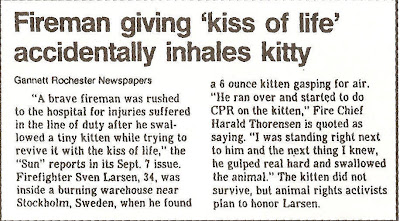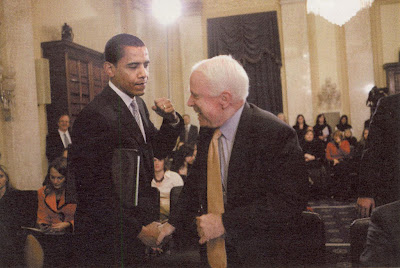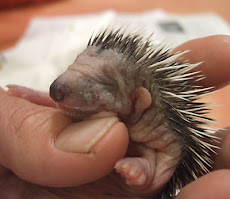
Using a Connection from an Orbital Moon Probe
Save me, my spaceship broke.
Saturday, February 28, 2009
From Drugs to Hugs

The War on Drugs
It's not the drugs; It's the war
For the last 20 years, the United States has been waging a so-called "War on Drugs". This war has been, at best, ineffective; at worst, an unmitigated disaster.
- The direct cost of the War on Drugs is something like 40 or 50 billion dollars per year
- the federal government will spend 19 billion dollars this year
- state and local law enforcement will add another 10 billion
- we spend 10 or 20 billion dollars each year keeping drug users in prison
- Indirect costs are estimated at 200 to 400 billion dollars per year
- crime
- disease
- lost wages
- lost taxes
- And then there are the intangible costs
- The United States now has 2 million people in prison
- Drug laws are widely disregarded and erratically enforced, which diminishes respect for law and government
- Drug laws fund organized crime and corrupt law enforcement
- The War on Drugs is tearing apart foreign countries, like Columbia, and communities within our own country
War is Hell
OK, so war is hell, and expensive, besides. Perhaps this is the cost of victory.
No.
This is the cost of defeat. We're losing the war on drugs. To see this, we only have to look at the drug business. Drugs are a business, and any business has two sides
- Demand
- Demand for illegal drugs in this country is small and constant
- 10 million of us use marijuana
- 2 million use cocaine in some form
- 0.5 million use heroin
- Supply
- On the supply side, the story is even simpler: supply is up. Over the last decade, street prices for drugs have fallen—dramatically—while the purity of the drugs has increased. Whatever else it's doing, the War on Drugs is not restricting the supply of drugs.
One reason that we are losing the War on Drugs is that we don't want to win it. There is not, in this country, any broad-based, principled objection to the use of drugs. We have legal drugs
- alcohol
- tobacco
- caffeine
- aspirin
- prozac
- penicillin
These drugs are widely used. They can cause health problems; they can be abused. We largely accept this. Even people who abstain from drugs, for personal, health, or religious reasons, generally regard that as—well—as a personal, health or religions matter. They don't seek to impose their abstention on the rest of society.
Neither is there any principled objection to the use of illegal drugs. They are illegal, but 100 million of us have used them. As a society, we've made these drugs illegal, but as individuals, we don't object to their use.
- Bill Clinton used marijuana, and we elected him president
- George W. Bush won't deny that he used cocaine, and we elected him president, too
The use of illegal drugs, in and of itself, is not an issue for people in this country.
In summary, the War on Drugs
- costs a lot of money
- does a lot of damage
- doesn't achieve its stated goals
and we don't even want it to achieve its stated goals
It's not the drugs; it's the war
What's going on? Why are we doing this?
- It's not the drugs
- It's the war
- Nothing about the War on Drugs makes any sense in the context of drugs
- Everything about the War on Drugs makes sense in the context of war
- We aren't running the War on Drugs because we want to eradicate drugs
- We're running the War on Drugs because we want to have a war.
More specifically, we're running the War on Drugs because it serves the interests of people in this country.
The United States is a democracy. Nothing
- this big
- this expensive
- this destructive
can go on in the United States—for decades—without broad-based political support. The War on Drugs has constituencies. It has groups of people who support it because it serves their interests.
These groups don't have to support the War on Drugs for the same reasons. They don't have to support it for good reasons. They don't even have to support it for coherent reasons. All that is necessary for the War on Drugs to continue is that enough people get something out of it, and that it doesn't seriously inconvenience the middle class, which it doesn't.
Constituencies
So who are these groups? Who are the constituents of the War on Drugs? Let's start with the obvious ones.
- The War on Drugs is an employment program for law enforcement. The War on Drugs employs
- everyone in the Drug Enforcement Administration
- people in the FBI, the INS, and the border patrol
- state and local police officers
- judges, and prosecuting attorneys, and defense attorneys
- prison wardens, and prison guards
- The War on Drugs supports the prison industry. Since we've put 2 million people behind bars, building, supplying, and running prisons has become big business. This alignment of government and business in running the prison system is sometimes called the prison-industrial complex.
- The War on Drugs serves the government. The government needs bogeymen. It needs threats that can be used to justify
- military intervention
- foreign intelligence operations
- greater domestic police powers
For many years, the international communist conspiracy played this role, but that hasn't been so credible since communism collapsed 10 years ago. Today, the government invokes the specter of international drug cartels when it needs to generate support for some extra-legal, unconstitutional, or otherwise ill-advised use of force.
- The War on Drugs serves the military-industrial complex. Last year, President Clinton asked for, and received, 1.3 billion dollars to send to Columbia to help them fight our War on Drugs. Of course, we didn't send a billion three in cash to Columbia, or even something moderately useful, like food or medicine. We sent them weapons. Built, of course, by American companies.
-
The War on Drugs serves politicians. Politicians
- need simple, emotional issues to drive their campaigns
- need issues that make good sound bites
- need issues that polarize discussion, so that they can claim the high ground, and label their opponents weak, or naive, or evil
These are some of the obvious beneficiaries of the War on Drugs. There are also groups that benefit in more subtle ways.
- The War on Drugs is an instrument of racial oppression. You won't find the words black, white, Caucasian, or Negro written into the laws, but the way the government treats drug users depends on the color of their skin. People with dark skin are treated more harshly at every level
- police make more arrests
- prosecutors file more charges
- juries return more convictions
- judges impose longer sentences
- The War on Drugs serves those who maintain political control by disenfranchising minorities. Convicted criminals generally can't vote; the ACLU estimates that the War on Drugs has permanently disenfranchised 14% of African-American men. We used to use poll taxes and literacy tests to keep people from voting; now we have the War on Drugs.
- The War on Drugs serves those who fear racial minorities. The history of drug laws in this country is a history of racial fear. Drugs were never outlawed because European-Americans were using them. Drugs were outlawed because minorities were using them
- Chinese-Americans
- Mexican-Americans
- African-Americans
- the '60s youth counter-culture
There are, today, people who fear minorities; the War on Drugs preferentially imprisons minorities; therefore, these people perceive that the War on Drugs serves their interests.
- The War on Drugs serves a society in search of scapegoats. Historically, people who needed someone to blame—or hate—had their choice of racial, ethnic, and religious groups. As Tom Lehrer famously observed in the song National Brotherhood Week:
The Protestants hate the Catholics
The Catholics hate the Protestants
The Hindus hate the Moslems
And everybody hates the JewsAnd if you needed a less parochial target, there were always the Communists. But the Communists have evaporated, and garden-variety ethnic bigotry has become mostly unacceptable in public discourse.
Today, the War on Drugs provides us with scapegoats. We identify drug users as dangerous, and evil. We blame them for the troubles of our society, and herd them into prisons. And as our troubles persist, we imprison more and more drug users, for longer and longer terms, under harsher and harsher conditions, thinking that if we can only punish them enough, then surely our troubles will leave us.
Now what?
So where do we go from here? How do we stop the madness?
- We have to acknowledge the cost, destruction, failure, and ultimate futility of the War on Drugs. We have to commit ourselves to ending it.
- We have to confront those in power: those who currently benefit and profit from the War on Drugs. This won't be easy. Support for the War on Drugs in this country is broad and deep, and the interests that it serves overlap and interlock in complex ways. Furthermore, most of the people running the War on Drugs don't think they are doing something evil. Most of them think they are doing their jobs. And they think those jobs are important and necessary.
- We have to create a vision of an alternative. The War on Drugs has been going on for so long that most people can no longer imagine a world without it. And the rhetoric of war has been effective: there is a unspoken—and unquestioned—assumption that the alternative to fighting this war is defeat. But this is a war that we are fighting against ourselves. The alternative isn't defeat, the alternative is peace.
To end the War on Drugs, all we have to do is stop fighting it
- take the laws off the books
- release the prisoners
- leave the drug users alone
We'll still have drugs; we'll still have drug problems. We just won't have the war. We have to create a vision that makes this a credible alternative for people in this country. If we can create the vision, then we can end this war.
Notes
- 2 million people in prison
- giving us the highest incarceration rate on the planet
- 100 million of us have used them
- A few years ago, I was at a party in an affluent suburb of Boston. Upstairs, the hosts were serving alcohol; downstairs, the guests were smoking marijuana. The next-door neighbor, who happens to be a police officer, was invited, and witnessed this; it wasn't a problem.
- extra-legal, unconstitutional, or otherwise ill-advised use of force
- Manuel Noreiga was an agent of the United States in Panama. He was on the payroll of the U.S. army and the CIA for over 30 years. When he no longer served the United States—when he became an embarrassment—our government invaded Panama, captured Noreiga, brought him back to the U.S., tried, convicted, and imprisoned him on...drug charges.
- military-industrial complex
- It's easy to talk about the prison-industrial complex, and the military-industrial complex, and imagine these big, faceless corporations using lobbyists and campaign contributions to get their way with congress. And doubtless, a certain amount of that goes on. But it's important to remember that corporations have employees, and employees live in congressional districts. Congressmen don't like to do things that put their own constituents out of work. The War on Drugs has political support on many levels.
- label their opponents weak, or naive, or evil
- President Clinton didn't send all those weapons to Columbia because he's specially concerned about Columbia, or the War on Drugs, or even about employment in the defense industry. He did it to protect Democratic candidates in the 2000 elections from Republican charges that they are "soft on drugs". He knew the attacks were coming: George W. Bush made his name in Texas by locking up drug users.
- keep people from voting
- There doesn't have to be an explicit conspiracy to do this. You needn't imagine politicians in a smoke-filled room inventing the War on Drugs to get African-Americans off the voting rolls. All that is necessary is that the War on Drugs has that effect; therefore, it serves those who benefit from that effect. The political system is adaptive: it protects the interests of those in power.
- history of racial fear
- The movie Reefer Madness stands as a reminder of the hysteria that is the foundation of our drug laws
Copyright © 2001 by Steven McDougall. All rights reserved.
 This work is licensed under a Creative Commons License.
This work is licensed under a Creative Commons License.See http://creativecommons.org/licenses/by-nc-nd/2.0/.
Steven McDougall / resume / swmcd@world.std.com / 2001 June 03
Thursday, February 26, 2009
Friday, February 20, 2009
Unertan syndrome. WTF ( What the FUCK!!!)
The Unertan Syndrome (UTS), first discovered by Tan in 2005 is characterized by three main symptoms: habitual walking on all four extremities; rudimentary intelligence with no conscious experience; and primitive language.
Cases
- Nine families exhibiting these symptons have been discovered, and so far all them are resident in southern Turkey, except for one who lives the northern Turkey region of Canakkale. The first discovered family lives in Demirkonak(Iskenderun), and has 19 children that are now between 15 and 37 years of age. Five of them exhibit the symptoms of UTS. The father and mother are relatives, and as such the pedigree analyses suggest an autosomal recessive transmission.
- A second and third family have also been discovered in Adana. These families are also relatives. Two individuals within this family exhibit symptoms of UTS. Although there is no intrafamilial marriage, the pedigree analysis suggested an autosomal recessive transmission in these families.
- A very large family was discovered in Eskikonak(Gaziantep). There are six subfamilies within this large family, with intrafamilal marriages, and six individuals exhibiting UTS. These families also demonstrate autosomal recessive transmission.
Recently, Tan discovered a new series of families with individuals exhibiting UTS in a rural area of Canakkale in northern Turkey. The discovery of affected individuals in the Canakkale family suggest an autosomal recessive transmission, without intra-familial marriages. In all of these families, there are also bipedal ataxic individuals.
Analysis
The MRI scans showed a cerebellar and vermial hypoplasias in the affected individuals, except that in Adana Family, which showed only a mild vermial hypoplasia. These results suggest that the main symptoms of the UTS may be caused by a vermial hypoplasia as a result of a chromosomal anomaly due to the autosomal recessive transmission. Chromosome 17p was affected in the first family resident in Demirkonak. Studies have shown that the affected individuals from other families have anomalies in different chromosomes, suggesting a multigenetic origin of the UTS.
A Brazilian family exhibiting UTS in all of the children born of a consanguineous couple was recently reported by Garcias et al. In accord with UTS, the affected individuals had qaudrupedal gait, severe mental retardation, and no language.
Symptoms
Walking style
The predominant symptom of UTS, is the quadrupedal gait. Nearly all of the individuals diagnosed stand up and maintain the upright position as long as they wish. Only a few of them are unable to stand up and maintain an upright posture. It is hypothesized that the main difficulty is the initiation of the necessary leg movement to take the first step using a leg (7). To do that, one has to maintain the body weight on the side opposite to the intended leg movement, i.e., to be able to stand onto one leg opposite to the leg intended to take a step, and vice versa. The truncal balance during standing is mainly controlled by the cerebellar vermis. However, the lateral balance during walking is different from the truncal balance during the upright posture (11).
The individuals have a normal sense of truncal balance during standing without any discomfort, but they lose balance if they try to take a step, transferring the body weight to the opposite leg and stabilizing it in an extensor position. The neural mechanisms of the bipedal gait are indeed very complex and not completely understood yet. Thus it is hypothesized that the neural control of gait is not limited to the cerebello-vermial control systems.
The normal walking movements of the legs are indeed possible with a normal spinal cord without any interference from the supraspinal centres (11). This can be demonstrated when a baby is held upright with the feet just touching the ground. A baby begins to move its legs as if stepping, while being unable to balance or support itself independently during stepping since the cerebellar and/or vermial systems needed to support the body during walking movements of the legs are not fully developed yet.
Lateral balance during upright walking may be referred to as asymmetric lateral balance and is instantaneously controlled by the spino-cerebro-cerebellar system in humans (11). If one compares quadrupedal walking in individuals with UTS against babies who make walking movements when held in the upright position, it can be concluded that the spinal walking movements with legs normally occur in individuals with UTS while walking on all four extremities even though they cannot manage the necessary postural adjustments during upright bipedal gait, thus the problem with asymmetric lateral balance.
All of the individuals with UTS can walk on all four extremities with great ease, as if it is their natural gait. They therefore likely have a preference for the quadrupedal gait, similar to the psychological variable of hand preference(a right-handed man can write using the right hand with great ease, contrary to the left hand which is very clumsy in writing. Therefore he may prefer his right hand in writing, and vice versa in left-handers. Although the right-hand preference is a psychologic manifestation, it has neural mechanisms).
Accordingly, a preference for the qudrupedal gait should also have neural mechanisms (7). Walking on all four extremities in children is called bear crawling, which is normal in some children before walking on two legs. Children walking on all four extremities were described thoroughly as early as 1928 by Hrdlicka, who reported 11 children walking on all four extremities for about eight months and then standing up and starting to walk bipedally (12). Thus, there may be a transitory period during child development on which bear crawling is exhibited.
However, as seen in UTS, some children may prefer bear crawling for the rest of their life and continue to walk on all four extremities. Apparently, the human quadrupedal gait seen in adults with UTS is a developmental throwback (see 6). The normal(average) development of a child, probably following the genetic software, may have stopped at a point of transition from quadrupedality to bipedality. To be able to progress from a quadrupedal gait, a relatively older walking style, into a newer walking style such as bipedal locomotion, the evolutionarily newer cerebro-cerebellar systems regulating asymmetric lateral balance for upright walking should be developed in children. If not, these children would remain at the older evolutionary stages, finding it quite easy, i.e., natural, to walk on all four extremities, as was habitually done by our ancestors.
Cognitive faculties
The intelligent actions were in a rudimentary level in the individuals with UTS. They could not answer a single question from the Mini-Mental State Examination Test adjusted for uneducated Turkish people.
This test attempts to measure the patients capabilities in five fields:
- orientation (date and location),
- registration (immediate recall of three words),
- attention and calculation (count backwards),
- recall (recall three items),
- language and drawing (name a few items, repeat a sentence, paper folding, draw a watch).
The patients always had zero scoes in this test, except one who had 2 points from a total of 30 points. Concerning the language, the individuals with UTS from the first family used a language with very limited vocabulary, while the others from the remaining families could not speak at all, using only a few sounds to express their everyday wishes. A disordered cortico-cerebellar system may explain the cognitive impairments in UTS individuals, as associated with the cerebellar cognitive affective syndrome. The severe mental impairments observed in individuals with UTS may be accounted for by the disruption of the cerebro-cerebellar circuits involved in cognition.
The cerebellum has reciprocal connections with the left inferior frontal gyrus and the left lateral temporal cortex . The role of cerebellum in speech production has been reported frequently. Namely, cerebellar lesions may alter verbal expression and produce slow, monotonus speech that is not understandable , as seen in the individuals exhibiting the UTS.
UTS vs ancestoral traits
The individuals with UTS exhibited ancestral features, such as walking on all four extremities with primitive or no language and rudimentary intelligence. Most of them had no language skills whatsoever, answering simple questions with a simple sound.
Finding the gene or genes responsible for these uncestral traits may illuminate the mechanisms, for instance, for the transition from our quadrupedal ancestors to our bipedal ancestors. Studying the fossil records have not been successful in this respect.
Indeed, we now have live models to study the human evolution, especially with regard to the much discussed transition from habitual quadrupedality to habitual bipedality. Herein, there has been no intent to insult or injure these individuals affected by UTS, rather this is an endeavor to better understand the mystery of human evolution.
UTS vs devolution
UTS cases are also interesting with respect to devolution. This is manifest in individuals with UTS as an experiment of nature. The term of devolution, originally used by Tan, with respect to the evolutionary direction of human beings, merely means a reappearance of an earlier trait, such as the reappearance of the habitual quadrupedal gait in some human beings. As a result of nature’s experiment, UTS with ancestral features re-appeared in these individuals.
The UTS cases are the first examples of devolution in humans. An evolution in reverse or reverse evolution was previously used in some animal studies. According to ScienCentralNews(08.31.06), Capecchi said that
“we are trying to reconstruct what happened during the normal evolutionary process.”
Similarly, by studying humans with devolution in UTS exhibiting our most important ancestral trait, such as the habitual qaudrupedal gait, we can understand the mechanisms for the transition from habitual qaudrupedality to habitual bipedality, which most likely occurred by punctuated evolution resulting from a genetic mutation, provided that we can determine the location of the gene or the gene pool responsible for the quadrupedal gait in humans with UTS.
This is apparently contrary to Darwin’s theory of gradual evolution. If the Darwin’s theory of gradual evolution would be correct, all of the monkeys would have started to walk bipedally long ago, at least imitating man. To elucidate the genetic mechanisms of the transition from quadrupedality to bipedality in human beings would be a groundbreaking scientific development in human history. Therefore, there is no reason to be insulted or suggest injury by the “Unertan Syndrome”.
Sources: thanks Guys!! http://en.citizendium.org/wiki/TI:Unertan_SyndromeWednesday, February 18, 2009
I'm gonna knock you in the face little bitch, said Obama

Some Possible Scenarios here...
- Obama wants to punch McCain in the face
- Obama is hoping McCain will use his left and fist bump like true brothas do
- Obama is left handed
- The chick in the orange behind Obama is fucking hot
- There are 2 women wearing orange which spells conspiracy
- McCain will die at age 79
- McCain is on drugs
- Ralph Nadar is in the bathroom.








